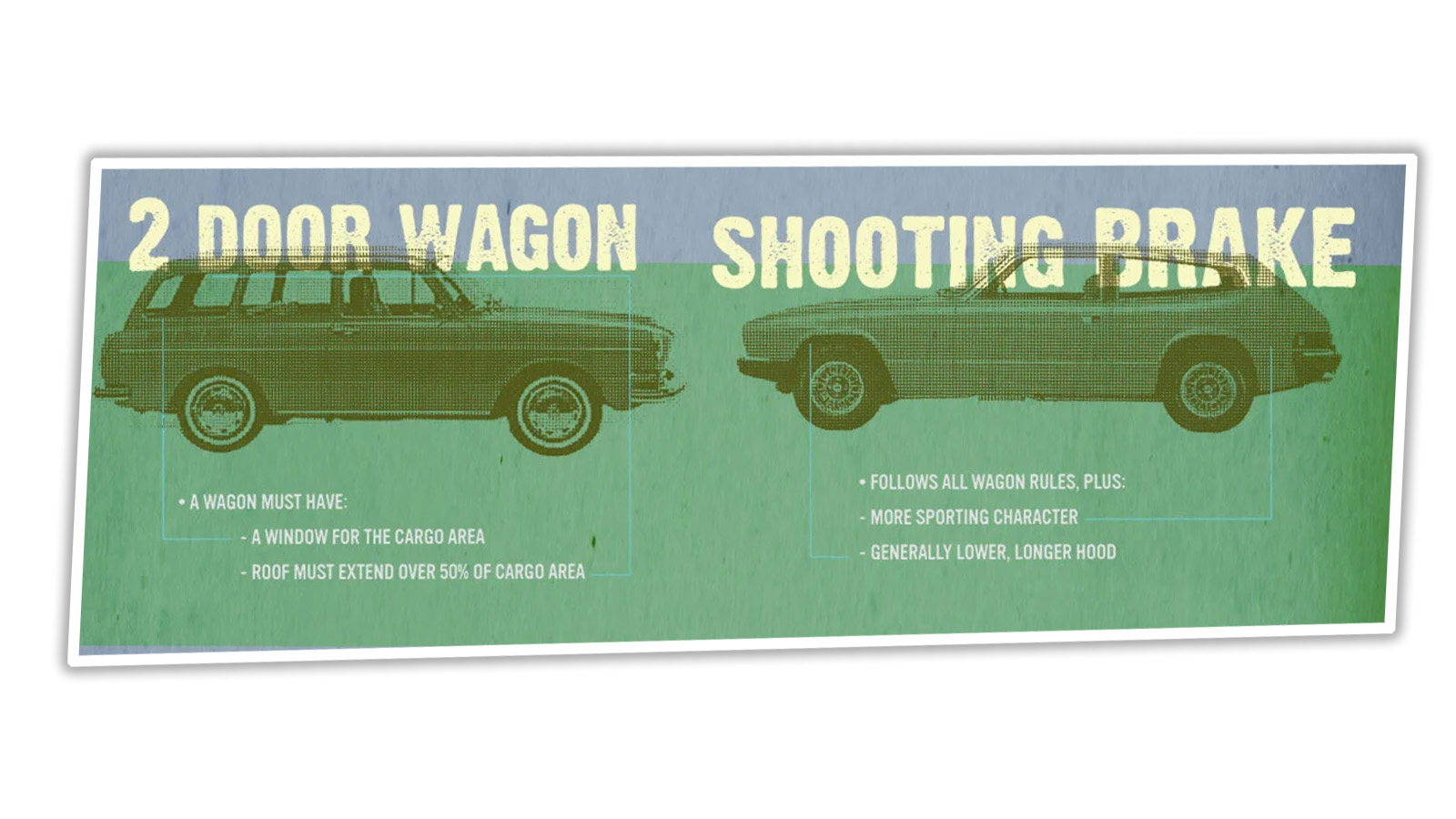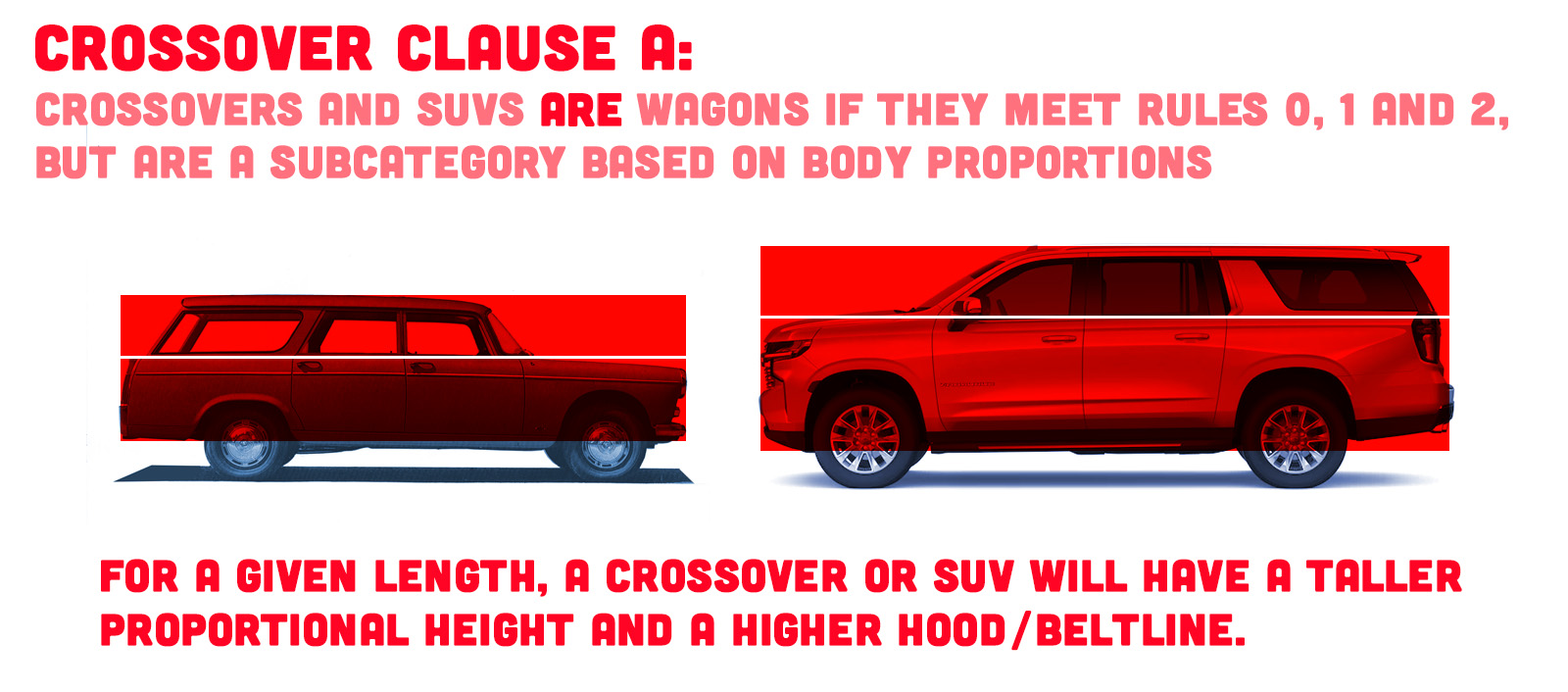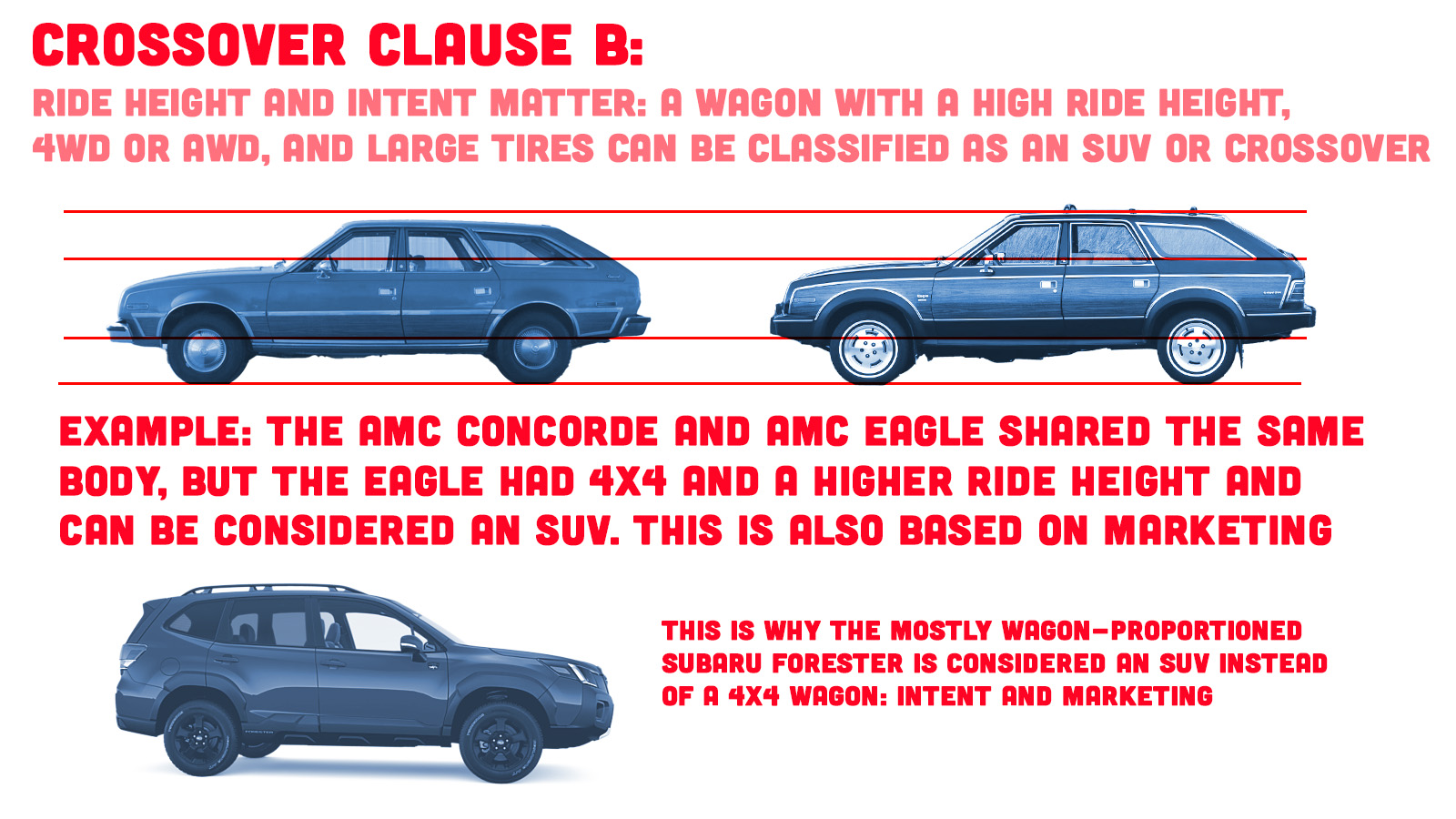This need was alerted to me via Twitter, when I was tagged in a post discussing a recent Jalopnik article about all the wagons currently for sale in the 2023 model year:
— Michael Sobczak (@thatsMrSOB) August 31, 2022 The subsequent thread of twitter-fighting about what is or isn’t a wagon was my wake up call that my people need me, and that this madness must be stopped. We all need to agree on just what makes a wagon, which is why I implore you to pay attention. First, let’s recap the original Two Rules of Wagonhood:
Rule 1 states that the cargo area of a wagon must be provided with side windows. The size or shape of such windows isn’t important, and the glass area of the window can be contiguous with a longer side window that extends from the rear passenger seat, if one is provided. It should be noted here that the number of doors does not matter: two, four, or even three doors are fine. You can have two door wagons, and, of course, there’s the sporty two-door wagon variant known as the Shooting Brake:
A car that has no window for the cargo area is either a hatchback, or perhaps a van derived from a car, but cannot be a wagon. The second classic Wagonhood Rule is that the roof of a wagon must cover at least half of the cargo floor:
This means that the roof will necessarily be a bit long, but this doesn’t affect the angle of the rear, or the type of rear door, be it tailgate, side-hinged door, hatch, or whatever. All that matters is that the roof extends over at least half of the floor space in the cargo area, even if that cargo area is small. A good example of the roof-length rule can be seen in the Volkswagen Dasher/Passat:
Both versions have window area on the sides of the cargo area, but only the Dasher Wagon has a roof that extends to cover over half of the cargo floor. In the original post, I had a few pass/fail examples:
Okay, I think these rules still stand, and should cover most examples of wagon identification. I did realize that I needed one other rule, though:
Rule 0 is the Two-Box rule. Now, I don’t think this will come up much, but I realized that a number of vans could pass Rules 1 and 2, but they’re clearly not station wagons, because a Wagon Must Be A Two-Box Design. That is, a wagon needs a hood of some kind, even if it has no engine in there or is a bit stumpy or whatever. Volkswagen tried calling the Microbus a Station Wagon in ads in the 1960s, but we all knew it really wasn’t one: it’s a van. Because a station wagon needs a hood, hence Rule 0. Okay, now let’s get into what I’m calling the Crossover Clauses. First, know this: Crossovers and SUVs are station wagons if they meet the now Three Rules of Wagonhood. So they can be wagons, but they are a subcategory of wagons, based on the following:
Crossover Clause A reminds us that if the proportions of a given wagon have a higher ratio of height to overall length and a comparatively high hood and beltline, they enter the subcategory of SUV or crossover. I wish I could have hard and fast ratios for this, but the wide variety of vehicle sizes and proportions make this nearly impossible. So, this is a bit subjective on paper, but pretty obvious in practice. Does the vehicle look tall? Is the hood high? Then it’s likely an SUV/crossover. We can further refine this subcategorization with Crossover Clause B:
Clause B states that both intent and ride height do matter. If a carmaker gives a vehicle a high ride height, big wheels, 4WD or AWD and a bunch of chunky cladding and a name that suggests something like rocky crags or the animals/people that bound over them, then it’s clear the intent of the vehicle is to be a crossover or SUV. A great example of this is the AMC siblings Concorde wagon and Eagle. The Concorde wagon was a RWD family wagon, while the Eagle had 4WD and higher ground clearance and bigger wheels, and was marketed as something to take off-road or camping or adventuring or hunting the Most Dangerous Game or whatever. Both cars had identical sheetmetal, bodies of the exact same dimensions. Yet AMC’s intent was clear: one’s a paved-roads family car, one’s an off-road sport utility vehicle, even if no one was calling them that at the time. Just look at how they were advertised:
One is sold as “affordable luxury” and one is “built tough, the American Way.” It’s clear there’s very different goals for these two similar, but not the same, cars. Make sense? Want to try a little test? Let’s do a car that meets the general Crossover Clauses, and see what we get: Hondas HR-V, one from 1999 and one from 2022:
Here’s an example where both could be considered crossovers from a proportion and intent standpoint, but only one, the 1999 one, is an actual wagon. This is very clear: the 2022 HR-V lacks a cargo side window, and the roof is too short to cover more than half of the cargo floor. Essentially, the new HR-V is a crossover-ized hatchback, not a wagon. Let’s do another Honda example:
The Fit is a wagon. Even if it’s small and has a very hatchback-like rear, it meets the basic criteria, so it’s a wagon. I hope this helps. Now more than ever it’s important that we find ways to all get along, and the first step to that is getting some real rules in place about what makes a station wagon. Godspeed. I very much agree with your updates to the rules! However, one thing stuck out to me that may further clarify the rules: rear overhang. While I agree with your classification of the 3rd Gen Civic Hatch and new Honda Fit as wagons, something seemed off. They are definitely cargo and practicality focused, but the proportions are too tall, to a point where I feel they violate the new Crossover Clauses. I believe, in my extremely finite and minor wisdom, that another addition to Rule 0 relating to front vs rear overhang ratio, would clarify much of the debate. In addition, upon rereading the original set of rules on that once-great automotive news site, I came across a comment which may introduce a further rule or clarification to the current rules. One commenter claimed their 2011 GTI was a wagon per the rules, which upset him. You replied back that due to a lack of window in the cargo area, it was not a wagon. But WAIT: what about the folding-seat cargo areas of many hatchbacks, which can operate primarily as cargo or passenger areas? I feel that a clarification of what defines a cargo area (dedicated area with all seats fixed in place) may help. Or, a clause that a hatchback that fits the wagon rules may only be a wagon with two doors. On the 2-door GTI, I feel that with seats down, it nears shooting brake territory. That’s how I left my 2-door’s seats all the time. But with four doors, now useless, opening to a folded seat? That, to me, seems wrong, as the doors serve no purpose unless the seats are up, and makes the 4-door GTI model itself NOT a wagon. Is this a wagon then? https://i.etsystatic.com/14685610/r/il/3c5195/3053368010/il_340x270.3053368010_iydj.jpg I personally find that wheel size makes the difference between a wagon and crossover. You can tell at a glance when the wheel is too big for a wagon.
- Make a website to upload photos of the vehicle desired to be evaluated for it’s wagon-ness. Might I suggest http://www.isitawagon.com it seems to be available. 2) Develop an impartial AI system to evaluate the photo. Be sure to include a bunch of buzz word stuff like machine-learning and cloud based neural networks. Throw in some block-chain for good measure. 3) The decision of the AI is final and whomever should challenge the authority of the great wagon AI shall be banished to purchase used Fiats from Kia dealerships for all eternity. -OR- Just make “Is it a Wagon?” a new Autopian feature and we can vote on it based on our collective wisdom. Torch has final say in case of a tie. WagonHood, WagonHood, Driving through the glen, WagonHood, WagonHood, With his band of men, Feared by the bad, loved by the good, WagonHood! WagonHood! WagonHood! Yeah, that’s pretty much what happened. He was really proud to correct me though. Then he tried to play the car up as super exclusive and hard to get. I walked away. And it was mainly a reshaping of the 2CV to have it fitting better with the time. ( cars with sharp angles ) For me, a rule should be that if you cover the rear 1/3 cargo area of the vehicle, does the front 2/3 look like a car, or does it look like a truck or van? If the front 2/3 looks like a car, then that is one step closer to being a wagon. A second rule would be the length of the cargo area. It should be at least a 1:1 ratio to the rear passenger seating area. The length from the back of the rear seat to the back of the front seat would be the gauge. The cargo length needs to be AT LEAST that long. So those Honda Fits wouldn’t qualify as a wagon in my mind. A third rule would be how you enter the vehicle. Do you sit down into the vehicle, or do you climb up to get into it? If you have to lift yourself up into the vehicle, it’s not a station wagon. If you sit down into the vehicle, like an average sized person would with pretty much any normal car, then you satisfy this rule. This would rule out any obvious SUVs or minivans or crossovers. This kind of goes along with the ride height/intent rule that Jason mentions. So, Jason, I feel you’ve failed to be a unifying force in this argument and have only served to be more divisive. Maybe we can vote on these rules? Put up a survey, Jason.











